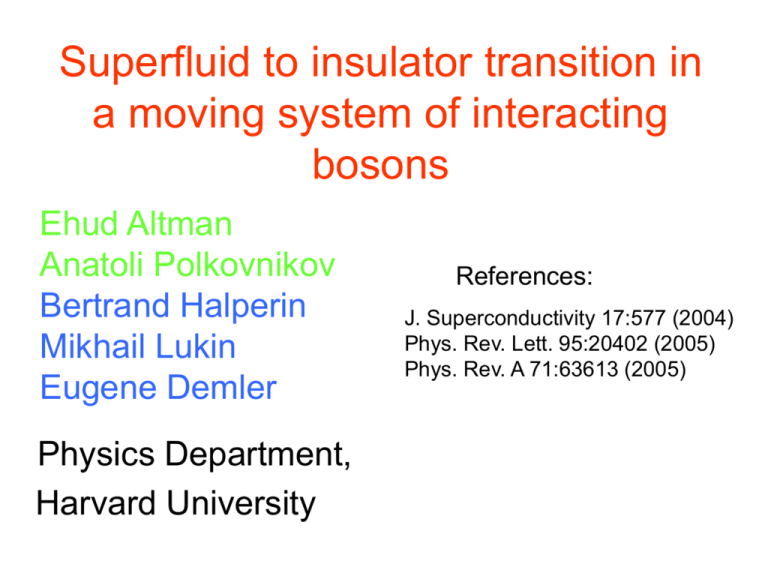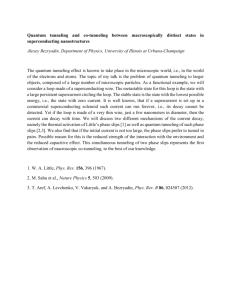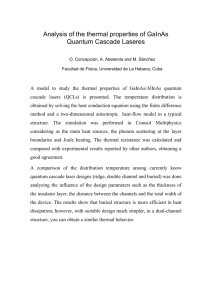ppt - Harvard Condensed Matter Theory group
advertisement

Superfluid to insulator transition in a moving system of interacting bosons Ehud Altman Anatoli Polkovnikov Bertrand Halperin Mikhail Lukin Eugene Demler Physics Department, Harvard University References: J. Superconductivity 17:577 (2004) Phys. Rev. Lett. 95:20402 (2005) Phys. Rev. A 71:63613 (2005) Outline Introduction. Cold atoms in optical lattices. Superfluid to Mott transition. Dynamical instability Mean-field analysis using Gutzwiller variational wavefunctions Current decay by quantum tunneling Current decay by thermal activation Conclusions Atoms in optical lattices. Bose Hubbard model Theory: Jaksch et al. PRL 81:3108(1998) Experiment: Kasevich et al., Science (2001) Greiner et al., Nature (2001) Cataliotti et al., Science (2001) Phillips et al., J. Physics B (2002) Esslinger et al., PRL (2004), … Equilibrium superfluid to insulator transition m Theory: Fisher et al. PRB (89), Jaksch et al. PRL (98) Experiment: Greiner et al. Nature (01) U Superfluid Mott insulator n 1 t/U Moving condensate in an optical lattice. Dynamical instability Theory: Niu et al. PRA (01), Smerzi et al. PRL (02) Experiment: Fallani et al. PRL (04) v Related experiments by Eiermann et al, PRL (03) This talk: How to connect the dynamical instability (irreversible, classical) to the superfluid to Mott transition (equilibrium, quantum) p p/2 Unstable Stable ??? SF This talk MI U/J p ??? Possible experimental U/t sequence: SF MI Superconductor to Insulator transition in thin films Bi films d Superconducting films of different thickness Marcovic et al., PRL 81:5217 (1998) Dynamical instability Classical limit of the Hubbard model. Discreet Gross-Pitaevskii equation Current carrying states Linear stability analysis: States with p>p/2 are unstable unstable unstable Amplification of density fluctuations r Dynamical instability for integer filling Order parameter for a current carrying state Current GP regime . Maximum of the current for When we include quantum fluctuations, the amplitude of the order parameter is suppressed decreases with increasing phase gradient . Dynamical instability for integer filling s (p) sin(p) p p/2 I(p) p 0.0 0.1 0.2 0.3 U/J * 0.4 0.5 Condensate momentum p/ Vicinity of the SF-I quantum phase transition. Classical description applies for Dynamical instability occurs for SF MI Dynamical instability. Gutzwiller approximation Wavefunction Time evolution We look for stability against small fluctuations 0.5 unstable 0.4 d=3 Phase diagram. Integer filling d=2 p/p 0.3 d=1 0.2 stable 0.1 0.0 0.0 0.2 0.4 U/Uc 0.6 0.8 1.0 Order parameter suppression by the current. Number state (Fock) representation Integer filling N-2 N-1 N N+1 N+2 N-2 N-1 N N+1 N+2 Order parameter suppression by the current. Number state (Fock) representation Integer filling Fractional filling N-2 N-1 N N+1 N+2 N-2 N-1 N N+1 N+2 N-3/2 N-3/2 N-1/2 N+1/2 N+3/2 N-1/2 N+1/2 N+3/2 Dynamical instability Integer filling Fractional filling p p p/2 p/2 U/J SF MI U/J Center of Mass Momentum Optical lattice and parabolic trap. Gutzwiller approximation 0.00 0.17 0.34 0.52 0.69 0.86 N=1.5 N=3 0.2 0.1 The first instability develops near the edges, where N=1 0.0 -0.1 U=0.01 t J=1/4 -0.2 0 100 200 300 Time 400 500 Gutzwiller ansatz simulations (2D) j phase j phase phase Beyond semiclassical equations. Current decay by tunneling Current carrying states are metastable. They can decay by thermal or quantum tunneling Thermal activation Quantum tunneling j phase phase Decay of current by quantum tunneling Quantum phase slip j j Escape from metastable state by quantum tunneling. WKB approximation S – classical action corresponding to the motion in an inverted potential. Decay rate from a metastable state. Example S 0 0 1 dx 2 2 3 d x bx 2m d ( pc p) 0 Weakly interacting systems. Quantum rotor model. Decay of current by quantum tunneling 1 d j S d 2 JN cos j 1 j 2U d j 2 j pj j At pp/2 we get For the link on which the QPS takes place 2 3 1 d j JN S d j 1 j JN cos p j 1 j 2U d 3 j 2 d=1. Phase slip on one link + response of the chain. Phases on other links can be treated in a harmonic approximation For d>1 we have to include transverse directions. Need to excite many chains to create a phase slip J || J cos p, J J Longitudinal stiffness is much smaller than the transverse. The transverse size of the phase slip diverges near a phase slip. We can use continuum approximation to treat transverse directions Weakly interacting systems. Gross-Pitaevskii regime. Decay of current by quantum tunneling p p/2 U/J SF MI Fallani et al., PRL (04) Quantum phase slips are strongly suppressed in the GP regime Strongly interacting regime. Vicinity of the SF-Mott transition p p/2 Close to a SF-Mott transition we can use an effective relativistivc GL theory (Altman, Auerbach, 2004) U/J SF M I 2 2 ip x 1 p e Metastable current carrying state: This state becomes unstable at pc 1 3 corresponding to the maximum of the current: I p p 1 p 2 2 . 2 Strongly interacting regime. Vicinity of the SF-Mott transition Decay of current by quantum tunneling p p/2 U/J SF Action of a quantum phase slip in d=1,2,3 MI - correlation length Strong broadening of the phase transition in d=1 and d=2 is discontinuous at the transition. Phase slips are not important. Sharp phase transition Decay of current by quantum tunneling 0.5 unstable 0.4 d=3 d=2 d=1 p/ 0.3 0.2 stable 0.1 0.0 0.0 0.2 0.4 U/Uc 0.6 0.8 1.0 phase phase Decay of current by thermal activation Thermal phase slip j j DE Escape from metastable state by thermal activation Thermally activated current decay. Weakly interacting regime DE Thermal phase slip Activation energy in d=1,2,3 Thermal fluctuations lead to rapid decay of currents Crossover from thermal to quantum tunneling Decay of current by thermal fluctuations Phys. Rev. Lett. (2004) Conclusions Dynamic instability is continuously connected to the quantum SF-Mott transition Quantum fluctuations lead to strong decay of current in one and two dimensional systems Thermal fluctuations lead to strong decay of current in all dimensions







